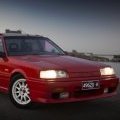Two Kinds Of Turbo?
Announcements
-
Similar Content
-
Latest Posts
-
Greg speaks wisdom. These dirty old Datsuns are only value when they are cheap. When they are not cheap, there is no value. Sounds contradictory, but it's true. We are now 20 years past the hey day of modifying cheap 90s JDM cars for small amounts of money. This is a different world. If you are rich and can afford not to care about what is effectively wasting money on an old Datto shitter, then I have no reason to argue against it. But if you are wanting to experience what we all experienced back in 2005 (and I bought my car last century!) then there is no way to do it.
-
Short answer: No. Medium answer: No, because you still need to conjure the things out of thin air to bolt them to a NA to make it a NA+T. Long Answer: No - The things you need to conjure - meaning a turbo, intercooling, manifolds, exhaust, intake/manifold/piping, clutch, injectors, fuel pump, AFM (?), ECU + Wiring (woo, N/A loom fun) have to come from somewhere. You could have many scavenged these things from an OEM car that someone had upgraded from and use some of these. This will be cost prohibitive now, especially so in the USA. You'd probably pay the same for newer, upgraded components that are better than old OEM stuff from 25-30 years ago. None of these big ticket items are re-usable for the N/A car. Why not buy new and upgrade while you're there? The only real consideration is turbo and fuel sizing and determining whether you want to stay within the bounds of the OEM engine or get into rebuild territory. These limits ARE lower with a N/A motor and especially N/A gearbox at the starting point. And if you're gonna upgrade those then you may as well consider having them built to begin with. Because everyone here knows you're never far from that next engine rebuild once you start making the power you want... The cars you see on the internet and SAU etc have been built over decades. If you're really clued in... you would sell your US car to somebody for what you paid for it. You would then scour AU JDM pages or SAU and buy a car like Dose's on this forum with your powerful American Dollar. This will save you so much money in the long term. Importing it could be tricky. Or it might not because USA. I have long said the only reason 90's Japanese stuff took off was because a) Japanese people had Japanese cars so that is what they used b) Australians could import these cars to Australia with very minimal changes and use them on the road here c) Neither country had well-priced access to US or EU Sports Cars. I don't believe the JDM scene would have taken off in Australia at all if we had EU priced EU BMW M offerings, or more especially the AUS V8 Scene would never have existed if we had the multitude of US cars like Camaros, Mustangs, Corvettes at the prices you folks do. After all - Do the math. I would say put a V8 in your R34 and that's the smart way forward. It is. I did it. I know this from my own experience. But at that point there's no reason to simply not buy a C5 or C6? It would be simpler and easier and cheaper and bette-
-
Reading all this... hurts lol. I have an ENR34 5MT and I paid an inflated USA price for the car alone, had to do tons of preventative maintenance past that, and so I'm over $30K USD into the car already and haven't even touched power. I wanted to +t it. Not even trying to make GTR numbers, I'd be happy with 250hp. Can I get away with paying much less to make that happen?
-
Great weekend and event. Open fire at the caravan park, perfect weather all day and a great feed and a couple of drinks at at awesome country pub.
-







Recommended Posts
Create an account or sign in to comment
You need to be a member in order to leave a comment
Create an account
Sign up for a new account in our community. It's easy!
Register a new accountSign in
Already have an account? Sign in here.
Sign In Now